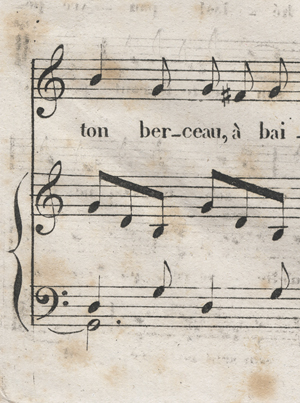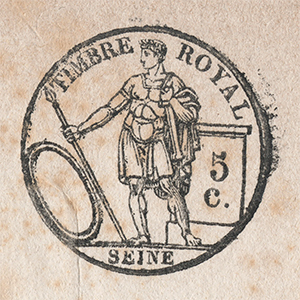 The evolution of French art song and popular song coincided with developments in printing over the course of the nineteenth century. The earlier pieces in this collection were printed from engraved plates, a method first developed in the late sixteenth century. The staves, notes, expressive marks, and text would be engraved in reverse onto a copper plate by an engraver. This plate would then be inked and pressed onto a piece of paper, often made from rags, imprinted with a stamp to indicate that the paper tax had been paid. A single plate, which would be numbered, served as the basis from which to print multiple copies. Because nineteenth-century French sheet music was usually undated, these plate numbers that appear at the bottom of the page serve as a means to date the music.
The evolution of French art song and popular song coincided with developments in printing over the course of the nineteenth century. The earlier pieces in this collection were printed from engraved plates, a method first developed in the late sixteenth century. The staves, notes, expressive marks, and text would be engraved in reverse onto a copper plate by an engraver. This plate would then be inked and pressed onto a piece of paper, often made from rags, imprinted with a stamp to indicate that the paper tax had been paid. A single plate, which would be numbered, served as the basis from which to print multiple copies. Because nineteenth-century French sheet music was usually undated, these plate numbers that appear at the bottom of the page serve as a means to date the music.
Developed by Alois Senefelder in the 1790s, lithography presented a method of quickly transferring an image onto paper multiple times. By the 1830s and 1840s, music publishers adopted the new process to print both sheet music and its cover illustration. As an inexpensive means of publishing music, lithography served to easily disseminate, and arguably democratize, song. As Devriès-Lesure has demonstrated, the 1830s witnessed the burgeoning industry of “musique à bon marché” (1987). Most songs were printed into two sizes: the “petit format” (16.5cm x 26cm) with only the text and vocal music cost between 30 centimes and 1 franc; the “grand format” (25cm x 33cm) with added piano accompaniment cost 3 francs. Sheet music could be acquired in several ways: from music publishers, music sellers, or at café-concerts; from street sellers; via a subscription from a music publisher; or as a journal supplement.
 The singers and atmosphere of the café-concerts, music halls, and cabaret-artistiques, were captured in vivid lithographic advertisements created by artists, such as Chéret, Ibels, Steinlen, and Toulouse-Lautrec. In the second half of the century, colour lithography also became the primary method of printing popular sheet music covers, including those designed by some of the same artists—there are several covers by Ibels in the collection. Although the attractive illustrations certainly enhanced the allure of sheet music, a popular singer could also help sell a piece. For instance, covers frequently advertised a particular singer performing the piece at a specific café-concert: “Créée par Mistinguett à l’Eldorado.” For well-known performers, the song could even be labeled as belonging to their repertoire via either a stamp or a note printed onto the piece itself. Back covers often served not only to advertise the publisher’s collection, but also to promote pieces performed by particular singers, which connected singers with particular genres of song and genres of performance; for instance, Amiati is often listed next to the romance patriotique and the genre patriotique.
The singers and atmosphere of the café-concerts, music halls, and cabaret-artistiques, were captured in vivid lithographic advertisements created by artists, such as Chéret, Ibels, Steinlen, and Toulouse-Lautrec. In the second half of the century, colour lithography also became the primary method of printing popular sheet music covers, including those designed by some of the same artists—there are several covers by Ibels in the collection. Although the attractive illustrations certainly enhanced the allure of sheet music, a popular singer could also help sell a piece. For instance, covers frequently advertised a particular singer performing the piece at a specific café-concert: “Créée par Mistinguett à l’Eldorado.” For well-known performers, the song could even be labeled as belonging to their repertoire via either a stamp or a note printed onto the piece itself. Back covers often served not only to advertise the publisher’s collection, but also to promote pieces performed by particular singers, which connected singers with particular genres of song and genres of performance; for instance, Amiati is often listed next to the romance patriotique and the genre patriotique.
Boorman, Stanley, Eleanor Selfridge-Field, and Donald W. Krummel. “Printing and publishing of music.” Grove Music Online. Oxford Music Online. Oxford University Press, accessed February 15, 2017, http://www.oxfordmusiconline.com/subscriber/article/grove/music/40101.
Caradec, François, and Alain Weill. Le café-concert. 2nd ed. Paris: Fayard, 2007.
Carew, Derek. “The Consumption of Music.” In The Cambridge History of Nineteenth-Century Music, edited by Jim Samson, 237–58. Cambridge: Cambridge University Press, 2002.
Devriès-Lesure, Anik. “La ‘musique à bon marché’ en France dans les années 1830.” In Music in Paris in the Eighteen-Thirties / La musique à Paris dans les années mil huit cent trente, edited by Peter Bloom, 229–50. Stuyvesant, NY: Pendragon Press, 1987.
–––––––. “Technological Aspects.” Translated by Joop Beusekamp and Rudolf Rasch. In Music Publishing in Europe 1600–1900: Concepts and Issues, Bibliography. Vol. 1: The Circulation of Music, edited by Rudolf Rasch, 64–88. Berlin: Berliner Wissenschaftsverlag, 2004.
Devriès, Anik, and François Lesure. Dictionnaire des éditeurs de musique français, Vol. 2, 1820–1914. Geneva: Minkoff, 1988.
Hopkinson, Cecil. A Dictionary of Parisian Music Publishers, 1700–1950. New York: Da Capo Press, 1979.
Horn, David, with David Sanjek. “Sheet Music.” In Continuum Encyclopedia of Popular Music of the World, Vol. 1: Media, Industry and Society, edited by John Shepherd, David Horn, Dave Laing, Paul Oliver, and Peter Wicke, 599–605. New York: Continuum, 2003.
King, A. Hyatt. Four Hundred Years of Music Printing. London: Trustees of the British Museum, 1964.
Klein, Jean-Claude. La chanson à l'affiche. Histoire de la chanson française du cafe-concert à nos jours. Paris: Du May, 1991.
Krummel, Donald W, and Stanley Sadie, eds. Music Printing and Publishing. New York: W.W. Norton, 1990.
Lebeau, Elisabeth. “Le timbre fiscal de la musique en feuilles de 1797 à 1840.” Revue de Musicologie 24, no. 73/74 (1945): 20–28.
Lenneberg, Hans. The Dissemination of Music: Studies in the History of Music Publishing. Lausanne, Switzerland: Gordon and Breach, 1994.
–––––––. “Music Publishing and Dissemination in the Early Nineteenth Century. Some Vignettes.” The Journal of Musicology 2, no. 2 (1983): 174–83.
Poole, Mary Ellen. “Chansonnier and Chanson in Parisian Cabarets Artistiques, 1881–1914”. PhD diss., University of Illinois at Urbana-Champaign, 1994.
Rasch, Rudolf, ed. The Circulation of Music in Europe 1600–1900. Vol. 2, A Collection of Essays and Case Studies. Berlin: Berliner Wissenschafts-Verlag, 2008.
Twyman, Michael. Early Lithographed Music: A Study Based on the H. Baron Collection. London: Farrand, 1996.
––––––. A History of Chromolithography: Printed Colour for All. London: British Library, 2013.

